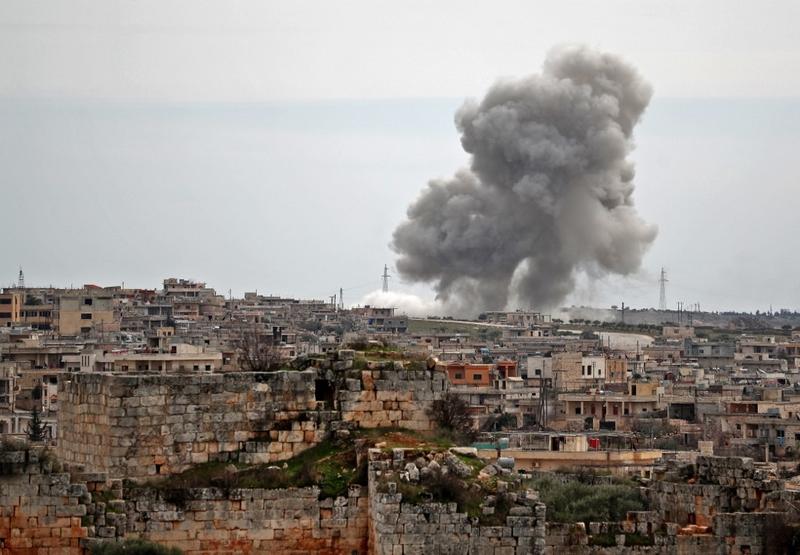 Plumes of smoke rise following Russian air strikes on the village of al-Bara in the southern part of Syria's northwestern Idlib province on March 5, 2020. (OMAR HAJ KADOUR / AFP)
Plumes of smoke rise following Russian air strikes on the village of al-Bara in the southern part of Syria's northwestern Idlib province on March 5, 2020. (OMAR HAJ KADOUR / AFP)
AMMAN/ISTANBUL — Deadly clashes erupted in southern Idlib on Friday, hours into a ceasefire deal between Russia and Turkey aimed at ending the fighting in the last rebel-held enclave in Syria.
A war monitor and a rebel source said the fighting broke out in the Jabal al-Zawiya region between Syrian government forces and jihadist insurgents of the Turkistan Islamic Party. Fifteen people were killed, the Syrian Observatory said.
Residents and opposition forces said the violence had abated elsewhere.
But the clashes underlined the fragility of Thursday’s deal between Russia, which backs President Bashar al-Assad’s forces, and Turkey. Ankara supports rebel fighters but has less sway over hardline jihadists who control large parts of Idlib.
Any ceasefire arrangement in Idlib, unless it has a no-fly zone dimension, is bound to fail
Galip Dalay, IPC-Mercator fellow at the German Institute for International and Security Affairs
ALSO READ: Russia, Turkey agree ceasefire deal for Syria's Idlib
The ceasefire aims to contain a conflict that has displaced nearly a million people in three months in northwest Syria.
Turkish President Tayyip Erdogan had vowed to reverse recent advances by Assad’s forces in Idlib. However, Thursday’s deal froze the conflict along existing front lines, cementing significant gains by Syrian government forces.
“There may be criticism but our priority was for a ceasefire and we achieved it. Some goals were not reached but that goes for both sides,” a senior Turkish official said.
Several previous deals to end the fighting in Idlib have collapsed. Analysts and residents said they feared the latest ceasefire would also fizzle out as it did not address the humanitarian crisis or air protection in any detail.
“Any ceasefire arrangement in Idlib, unless it has a no-fly zone dimension, is bound to fail. Deals in the past never de-escalated. They merely froze the crisis until the next escalation,” said Galip Dalay, IPC-Mercator fellow at the German Institute for International and Security Affairs.
Arriving for a meeting of European Union foreign ministers in Zagreb, Dutch minister Stef Blok said the ceasefire deal should be cemented with a no-fly zone to stop any further bombing of hospitals.
HUMANITARIAN CRISIS
The recent fighting sparked what the United Nations says may be the worst humanitarian crisis yet in a war that has driven millions from their homes and killed hundreds of thousands.
Russia had repeatedly played down any talk of a refugee crisis and accused Turkey of violating international law by pouring troops and equipment into Idlib since early last month. About 60 Turkish troops have been killed in that time.
Turkey, which has the second largest army in the transatlantic NATO alliance, has tried to resist the Syrian government advance and prevent a wave of refugees over its southern border. It already hosts 3.6 million Syrian refugees.
The ceasefire deal establishes a security corridor stretching 6 km (3.7 miles) to the north and south of Idlib’s east-west M4 highway, where joint Russian-Turkish patrols will begin on March 15 - effectively advancing Russia’s presence further north into Idlib.
Russian President Vladimir Putin said on Thursday he hoped the deal “will serve as a good basis for a cessation of military activity in the Idlib de-escalation zone”.
Erdogan said the sides would work together to supply aid to Syrians in need, but that Turkey retained the right to “respond to all (Syrian) regime attacks in the field.”
“VERY TENSE CALM”
Residents and fighters in the region said the front lines, which have seen heavy air strikes by Russian and Syrian jets and intense Turkish artillery and drone strikes on Assad’s forces, were quiet in much of the region after the midnight ceasefire came into effect.
“There is a ceasefire but there are violations,” said Abdul Ghani al Sheikh, a rebel fighter from the Turkey-backed Failaq Sham rebel group. He said government forces were shelling Jabal al Zawya and Atareb, to the south and east of Idlib.
“But the situation overall is better. Everyone thinks this is all temporary and Turkish reinforcements are still coming.”
READ MORE: Putin tells Erdogan they should not ruin relations over Syria
The Syrian Observatory for Human Rights monitoring group reported that the first eight hours of the ceasefire had passed with “relative calm”, and the skies had been free of Syrian government and Russian warplanes.
A Syrian state reporter, broadcasting from the town of Saraqeb recaptured by Syrian forces last week, said they were reinforcing positions at the frontlines.
The ceasefire deal did not detail a “safe zone” or describe how displaced people could return to the homes they have fled to escape the Russian-backed offensive.
“No one has mentioned a safe zone or areas of withdrawal. There is no pullout, and where will the displaced go (who) would never accept going to (Assad) regime areas? What we have heard is not comforting,” said Ahmad Rahhal, a former general in the Syrian government forces who defected to the opposition.


